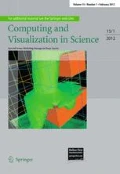Abstract
A posteriori error estimates for the obstacle problem are established in the framework of the hypercircle method. To this end, we provide a general theorem of Prager–Synge type. There is now no generic constant in the main term of the estimate. Moreover, the role of edge terms is elucidated, and the analysis also applies to other types of a posteriori error estimators for obstacle problems.
Similar content being viewed by others
References
Ainsworth M. and Oden T.J. (2000). A Posteriori Error Estimation in Finite Element Analysis. Wiley, Chichester
Bartels S. and Carstensen C. (2004). Averaging techniques yield reliable a posteriori finite element error control for obstacle problems. Numer. Math. 99: 225–249
Braess D. (2007). Finite Elements: Theory, Fast Solvers and Applications in Solid Mechanics, 3rd edn. Cambridge University Press, London
Braess D. (2005). A posteriori error estimators for obstacle problems—another look. Numer. Math. 101: 415–421
Braess D., Carstensen C. and Hoppe R.H.W. (2007). Convergence analysis of a conforming adaptive finite element method for an obstacle problem. Numer. Math. 107: 455–471
Braess, D., Carstensen, C., Hoppe, R.H.W.: Error reduction in adaptive finite element approximation of elliptic obstacle problems (in preparation)
Braess D. and Schöberl J. (2008). Equilibrated residual error estimator for edge elements. Math. Comp. 77: 651–672
Luce R. and Wohlmuth B. (2004). A local a posteriori error estimator based on equilibrated fluxes. SIAM J. Numer. Anal. 42: 1394–1414
Morin P., Nochetto R.H. and Siebert K.G. (2000). Data oscillation and convergence of adaptive FEM. SIAM J. Numer. Anal. 38: 466–488
Neittaanmäki, P., Repin, S.: Reliable Methods for Computer Simulation. Error Control and A Posteriori Estimates. Elsevier, Amsterdam (2004)
Prager W. and Synge J.L. (1947). Approximations in elasticity based on the concept of function spaces. Q. Appl. Math. 5: 241–269
Repin S.I. (2003). Estimates of deviations from exact solutions of elliptic variational inequalities. J. Math. Sci. 115: 2811–2819
Siebert K. and Veeser A. (2007). A unilaterally constrained quadratic minimization with adaptive finite elements. SIAM J. Optim. 18: 260–289
Veeser A. (2001). Efficient and reliable a posteriori error estimators for elliptic obstacle problems. SIAM J. Numer. Anal. 39: 146–167
Weiss, A., Wohlmuth, B.: A posteriori error estimator and error control for contact problems. IANS Report 12/2007, University of Stuttgart
Author information
Authors and Affiliations
Corresponding author
Additional information
Communicated by G. Wittum.
Dedicated to Wolfgang Hackbusch on occasion of his 60th birthday.
Rights and permissions
About this article
Cite this article
Braess, D., Hoppe, R.H.W. & Schöberl, J. A posteriori estimators for obstacle problems by the hypercircle method. Comput. Visual Sci. 11, 351–362 (2008). https://doi.org/10.1007/s00791-008-0104-2
Received:
Accepted:
Published:
Issue Date:
DOI: https://doi.org/10.1007/s00791-008-0104-2



